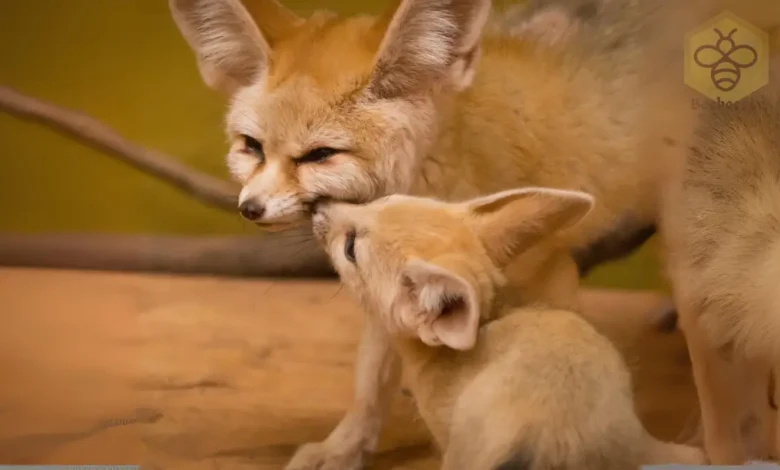Fennec Fox: Habitat, Diet, Reproduction, Size, and more…

Fennec: A Desert Survivor with Remarkable Adaptations
Fennec Fox
Introduction
The fennec fox (Vulpes zerda), often called the “fennec,” is a small and agile fox known for its huge ears and adaptability to desert environments. Native to the Sahara Desert and other parts of North Africa, the fennec fox has evolved unique physical and behavioral traits to survive in harsh, arid landscapes.
Scientific Name
The scientific name of the fennec fox is Vulpes zerda, which belongs to the family Canidae.
Common Name
The common name of this species is “fennec fox,” though it is often simply called “fennec.”
Scientific Classification
| Kingdom | Animalia |
| Phylum | Chordata |
| Class | Mammalia |
| Order | Carnivora |
| Family | Canidae |
| Genus | Vulpes |
| Species | Vulpes zerda |
Types of Fennec Foxes
While there are no recognized subspecies of the fennec fox, individual populations may vary slightly in size or coat color based on their geographic location. However, all fennec foxes share the same fundamental traits and characteristics, making them easily identifiable as a single species.
Habitat
Fennec foxes are adapted to live in desert regions, primarily inhabiting the Sahara Desert and other arid areas of North Africa, including parts of Morocco, Egypt, and northern Sudan. They are also found in the Arabian Peninsula. These foxes thrive in sandy deserts and semi-arid environments with sparse vegetation. Fennecs are nocturnal, a behavior that helps them avoid the extreme heat of the desert during the day. They live in burrows that they dig in the sand, which provide shelter from both predators and the scorching temperatures.
Physical Characteristics
The fennec fox is instantly recognizable due to its oversized ears, which can reach up to 6 inches in length. These large ears are not just for show; they play a crucial role in helping the fennec dissipate heat and detect prey from long distances. Other physical features include:
- Size: Fennec foxes are the smallest canid species, measuring between 9 to 16 inches in body length, with a tail that adds 7 to 12 inches. They typically weigh around 2 to 3.5 pounds.
- Fur: Their soft, thick fur is pale cream or sandy-colored, which helps reflect the sun’s heat and provides excellent camouflage in the desert.
- Feet: The soles of their feet are covered with thick fur, which protects them from the hot sand and allows them to walk more easily on loose desert surfaces.
Diet
Fennec foxes are omnivorous, and their diet consists of various foods available in their harsh environment. They primarily eat insects, small rodents, birds, and eggs. In addition to meat, they also consume fruits, berries, and leaves. Fennecs have a highly efficient metabolism that allows them to go for long periods without water, obtaining most of their moisture from the food they eat.
- Favorite Foods: Insects like locusts, beetles, and grasshoppers, as well as rodents like gerbils, are staples in the fennec’s diet. When fruits are available, they will eat them for additional hydration.
Predators and Threats
While fennec foxes are relatively well-protected in their desert environment, they still face several natural predators, including:
- Birds of Prey: Large birds like eagles and owls pose a significant threat, especially to young fennec foxes.
- Larger Mammals: Carnivorous mammals like jackals and hyenas occasionally prey on fennecs.
In addition to natural predators, fennec foxes face human-induced threats, such as habitat destruction, poaching for the illegal pet trade, and being hunted for their fur.
Reproduction, Babies, and Lifespan
Fennec foxes typically mate once a year, and their breeding season usually occurs between January and February. After a gestation period of about 50 days, the female gives birth to a litter of 2 to 5 kits (babies). Fennec fox kits are born blind and helpless, relying entirely on their mother for care and nourishment.
- Weaning and Independence: Kits are weaned at around 5 weeks of age, and they begin exploring their surroundings soon after. By the time they are 3 months old, they are capable of hunting on their own.
- Lifespan: In the wild, fennecs live for about 10 years, while in captivity, they can live up to 14 years due to better access to food and healthcare.

Population
The population of fennecs is currently stable, although exact numbers are difficult to estimate due to their remote habitats and elusive nature. They are classified as “Least Concern” by the International Union for Conservation of Nature (IUCN), but localized threats such as habitat loss and poaching could impact populations in specific areas.
Behavior and Lifestyle
Fennecs are highly social animals, often living in small family groups that consist of a mated pair and their offspring. However, they are also known to be solitary hunters, particularly when foraging for food. Their nocturnal behavior helps them avoid the desert heat, and their large ears not only help them detect prey but also serve as an important cooling mechanism.
- Burrowing: Fennecs are excellent diggers and construct complex burrows that can be up to 10 feet deep. These burrows provide shelter from predators and extreme temperatures.
- Communication: Fennecs communicate using a variety of vocalizations, including barks, growls, and yelps. They also use body language, such as tail movements, to convey their emotions or intentions.
Ecological Role
As omnivores, fennecs play an important role in controlling insect populations and dispersing plant seeds, which helps maintain the ecological balance of their desert habitats. By preying on small mammals and insects, fennecs help regulate the populations of these animals, preventing them from becoming too abundant. Additionally, their burrowing activity helps aerate the soil, which can promote plant growth in desert ecosystems.
FAQs About Fennec Foxes
- Where do fennec foxes live?
Fennec foxes are native to the Sahara Desert and other arid regions of North Africa and the Arabian Peninsula. - What do fennec foxes eat?
Fennec foxes eat a wide variety of foods, including insects, small rodents, birds, eggs, fruits, and leaves. - How long do fennec foxes live?
In the wild, fennec foxes live for about 10 years, while in captivity, they can live up to 14 years. - Are fennec foxes social animals?
Yes, fennec foxes are social animals and often live in small family groups, though they hunt alone. - Why do fennec foxes have such large ears?
The fennec’s large ears help dissipate heat and provide excellent hearing, allowing them to detect prey from long distances.
Conclusion
The fennec is an extraordinary example of nature’s adaptability, with its unique physical and behavioral traits perfectly suited for life in the desert. From their oversized ears that help regulate body temperature to their social structures and nocturnal habits, fennecs are well-equipped to survive in one of the harshest environments on Earth. Although their population is currently stable, it is crucial to protect these remarkable creatures from habitat destruction and illegal hunting, ensuring that they continue to thrive in the wild.


